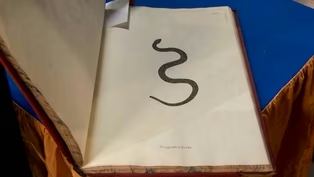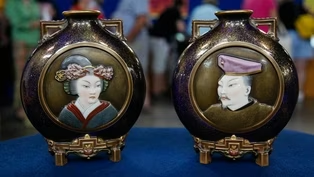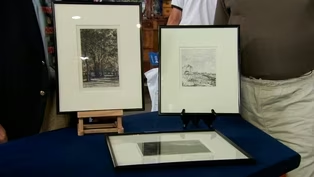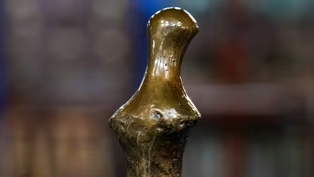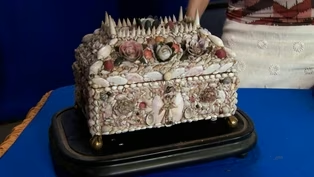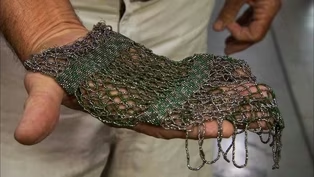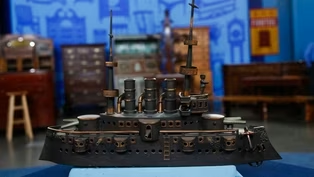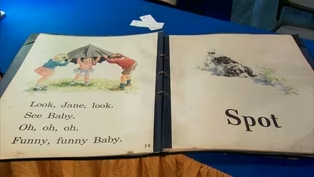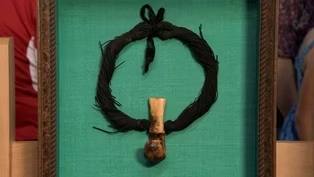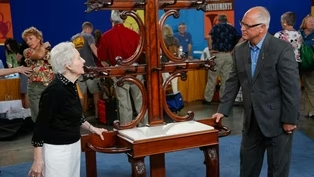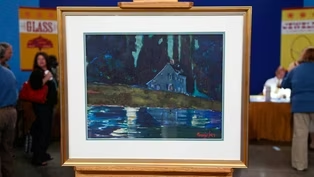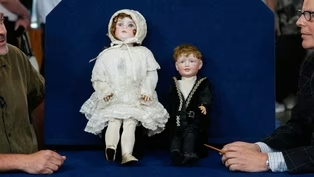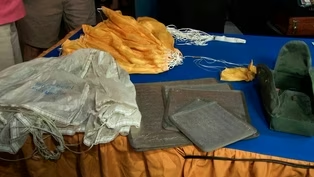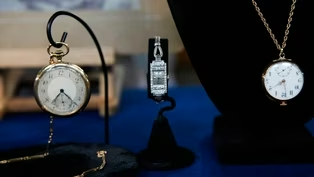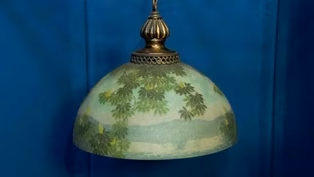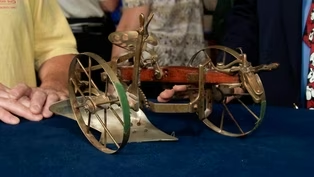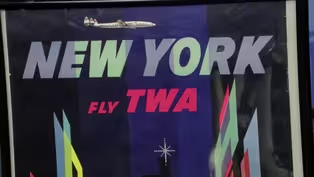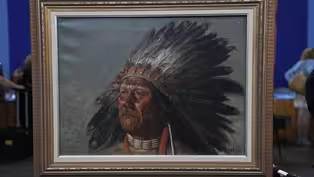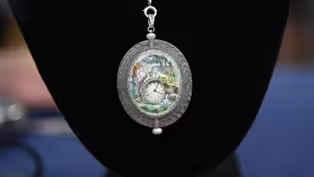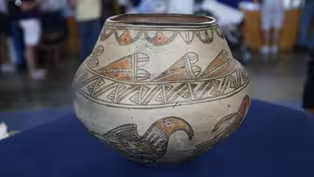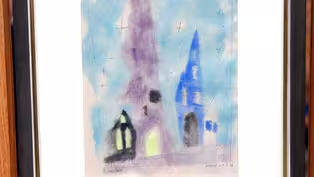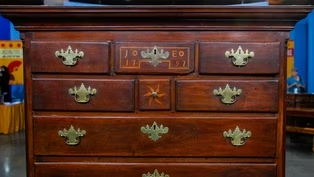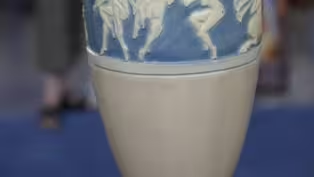
Appraisal: 1917 First Women Yeomen's Battalion Flag
Clip: Season 29 Episode 21 | 2m 47sVideo has Closed Captions
Appraisal: 1917 First Women Yeomen's Battalion Flag
Watch Gary Piattoni appraise a 1917 first women yeomen's battalion flag in Vintage Phoenix 2025, Hour 2.
Problems playing video? | Closed Captioning Feedback
Problems playing video? | Closed Captioning Feedback
Funding for ANTIQUES ROADSHOW is provided by Ancestry and American Cruise Lines. Additional funding is provided by public television viewers.

Appraisal: 1917 First Women Yeomen's Battalion Flag
Clip: Season 29 Episode 21 | 2m 47sVideo has Closed Captions
Watch Gary Piattoni appraise a 1917 first women yeomen's battalion flag in Vintage Phoenix 2025, Hour 2.
Problems playing video? | Closed Captioning Feedback
How to Watch Antiques Roadshow
Antiques Roadshow is available to stream on pbs.org and the free PBS App, available on iPhone, Apple TV, Android TV, Android smartphones, Amazon Fire TV, Amazon Fire Tablet, Roku, Samsung Smart TV, and Vizio.
Buy Now
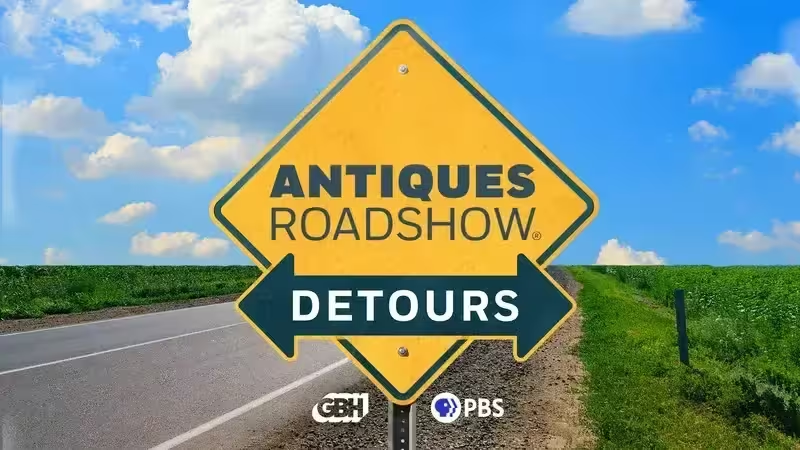
ANTIQUES ROADSHOW DETOURS
Ever wondered what happens to the treasures featured on America’s beloved ANTIQUES ROADSHOW after the cameras leave town? Host Adam Monahan tracks down the juicy afterlives of your favorite finds from PBS’s hit series.Providing Support for PBS.org
Learn Moreabout PBS online sponsorshipGUEST: My first tour in the Navy, I was an ensign, I went to my first command, the building we were in they were renovating, so they called us and said, "You have some trash here, come get rid of it."
I sent my sailors over to throw the stuff away.
They saw this flag, it says "women" on it, I'm a woman, so they brought it to me.
GUEST: And I carted it around for the rest of my 26 years in the Navy.
I know women were in the Navy in 1917.
There were 600.
A year later, there was 11,000 women.
And they did yeoman jobs, which is clerical work.
APPRAISER: Clerks and accountants and things like that.
GUEST: Absolutely.
APPRAISER: And you mentioned, in 1917-- which is interesting, because at the time, the secretary of the Navy saw the term yeoman and said, "It doesn't just mean 'man.'"
GUEST: Right.
APPRAISER: They needed every able-bodied person they could.
GUEST: Correct.
APPRAISER: So they brought the women in to do yeoman's work, which a lot of folks don't know that women were there during the First World War.
GUEST: That's right.
APPRAISER: And this is a First World War period flag.
It's silk with hand-painted emblems on it.
GUEST: Okay.
APPRAISER: The First Naval District was at Portsmouth, New Hampshire, late, later Boston.
GUEST: It started in Portsmouth in the, in 1903, went to Boston about mid-'40s.
APPRAISER: The great thing about this flag is that it shows the kind of patriotic nature that-that the women must have had at the time in order to really gear them up to be a part of the service.
In the center we have the U.S.
Naval insignia, which is still in use today on officer's cap badges, the eagle over the shield over the crossed anchors.
Now, I couldn't find out too much about the Women's Battalion either, but we still know that women were in service during the First World War and they did do a lot of yeoman's work.
It may have even been done by the women themselves as something that they wanted to use to-to inspire the rest of the women in the battalion.
And maybe they had it on base as an unofficial flag.
GUEST: Is it something that a museum, a Navy museum or women-in-the-military museum, might be interested in having?
APPRAISER: If you think you're going to keep it, it's worthy of conservation.
If you're going to donate it, the best thing to do is really let the institution decide how to handle the conservation.
GUEST: Okay.
APPRAISER: Because it's going to need to be cleaned, going to need to address these issues where it's starting to split, because the weight of the banner itself is pulling it apart.
So it depends on what you want to do.
But there's no doubt that interest in women in the service has grown over the years.
There'd be many institutions that would love to have this banner.
In this condition, I would say it's around $1,500, maybe $2,500.
GUEST: Okay.
APPRAISER: Fixed up would certainly enhance the value, but that would be a costly undertaking, so you really have to decide, "do I want to own it "or do I want to give it to somebody who could display it?"
Appraisal: 1799 Patrick Russell Indian Serpents Book
Video has Closed Captions
Clip: S29 Ep21 | 32s | Appraisal: 1799 Patrick Russell Indian Serpents Book (32s)
Appraisal: 1873 Royal Worcester Japonisme Flask Vases
Video has Closed Captions
Clip: S29 Ep21 | 3m 2s | Appraisal: 1873 Royal Worcester Japonisme Flask Vases (3m 2s)
Appraisal: 18th & 19th C. Etchings
Video has Closed Captions
Clip: S29 Ep21 | 1m 16s | Appraisal: 18th & 19th C. Etchings (1m 16s)
Appraisal: 1982 Henry Moore "Half-Figure: Round Head" Bronze
Video has Closed Captions
Clip: S29 Ep21 | 2m 39s | Appraisal: 1982 Henry Moore "Half-Figure: Round Head" Bronze (2m 39s)
Appraisal: 19th C. Shell-encrusted Casket
Video has Closed Captions
Clip: S29 Ep21 | 34s | Appraisal: 19th C. Shell-encrusted Casket (34s)
Appraisal: Cut Steel Handbag, ca. 1920
Video has Closed Captions
Clip: S29 Ep21 | 1m 49s | Appraisal: Cut Steel Handbag, ca. 1920 (1m 49s)
Appraisal: Dent Hardware Toy Battleship, ca. 1920
Video has Closed Captions
Clip: S29 Ep21 | 2m 48s | Appraisal: Dent Hardware Toy Battleship, ca. 1920 (2m 48s)
Appraisal: "Dick and Jane" Teacher's Edition Book, ca. 1950
Video has Closed Captions
Clip: S29 Ep21 | 38s | Appraisal: "Dick and Jane" Teacher's Edition Book, ca. 1950 (38s)
Appraisal: Early 19th C. Hawaiian Lei Niho Palaoa
Video has Closed Captions
Clip: S29 Ep21 | 1m 14s | Appraisal: Early 19th C. Hawaiian Lei Niho Palaoa (1m 14s)
Appraisal: English Regency Hall Tree, ca. 1840
Video has Closed Captions
Clip: S29 Ep21 | 3m 1s | Appraisal: English Regency Hall Tree, ca. 1840 (3m 1s)
Appraisal: George Luks Watercolor, ca. 1925
Video has Closed Captions
Clip: S29 Ep21 | 3m 14s | Appraisal: George Luks Watercolor, ca. 1925 (3m 14s)
Appraisal: German Dolls in Original Clothes, ca. 1905
Video has Closed Captions
Clip: S29 Ep21 | 2m 57s | Appraisal: German Dolls in Original Clothes, ca. 1905 (2m 57s)
Appraisal: NASA Parachutes & Pot Handles, ca. 1965
Video has Closed Captions
Clip: S29 Ep21 | 1m 20s | Appraisal: NASA Parachutes & Pot Handles, ca. 1965 (1m 20s)
Appraisal: Patek Philippe & Swiss Watch Collection
Video has Closed Captions
Clip: S29 Ep21 | 3m 48s | Appraisal: Patek Philippe & Swiss Watch Collection (3m 48s)
Appraisal: Reverse-painted Handel Shade, ca. 1920
Video has Closed Captions
Clip: S29 Ep21 | 1m 4s | Appraisal: Reverse-painted Handel Shade, ca. 1920 (1m 4s)
Appraisal: Salesman's Sample Plow, ca. 1880
Video has Closed Captions
Clip: S29 Ep21 | 35s | Appraisal: Salesman's Sample Plow, ca. 1880 (35s)
Appraisal: 1956 David Klein TWA Poster
Video has Closed Captions
Clip: S29 Ep21 | 2m 59s | Appraisal: 1956 David Klein TWA Poster (2m 59s)
Appraisal: Charles Craig Oil Portrait, ca. 1910
Video has Closed Captions
Clip: S29 Ep21 | 3m 30s | Appraisal: Charles Craig Oil Portrait, ca. 1910 (3m 30s)
Appraisal: Enamel & Rock Crystal Pendant Watch, ca. 1910
Video has Closed Captions
Clip: S29 Ep21 | 2m 10s | Appraisal: Enamel & Rock Crystal Pendant Watch, ca. 1910 (2m 10s)
Appraisal: Montoya & Vigil San Ildefonso Pueblo Pot, ca. 1880
Video has Closed Captions
Clip: S29 Ep21 | 2m 54s | Appraisal: Montoya & Vigil San Ildefonso Pueblo Pot, ca. 1880 (2m 54s)
Appraisal: 1921 Lyonel Feininger "Silver Stars" Watercolor
Video has Closed Captions
Clip: S29 Ep21 | 2m 50s | Appraisal: 1921 Lyonel Feininger "Silver Stars" Watercolor (2m 50s)
Appraisal: 1797 Chester County Marriage Chest
Video has Closed Captions
Clip: S29 Ep21 | 3m 8s | Appraisal: 1797 Chester County Marriage Chest (3m 8s)
Appraisal: Roseville Experimental Vase, ca. 1925
Video has Closed Captions
Clip: S29 Ep21 | 2m 9s | Appraisal: Roseville Experimental Vase, ca. 1925 (2m 9s)
Providing Support for PBS.org
Learn Moreabout PBS online sponsorship
- Home and How To

Hit the road in a classic car for a tour through Great Britain with two antiques experts.













Support for PBS provided by:
Funding for ANTIQUES ROADSHOW is provided by Ancestry and American Cruise Lines. Additional funding is provided by public television viewers.


